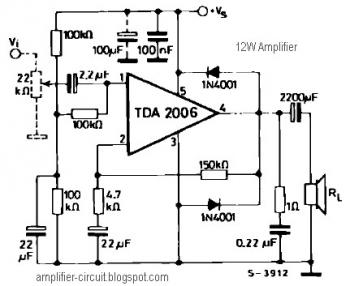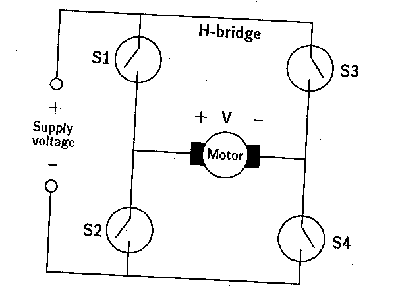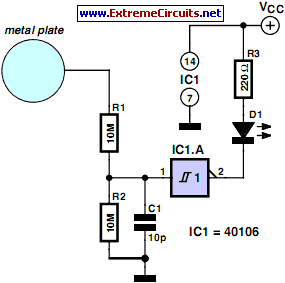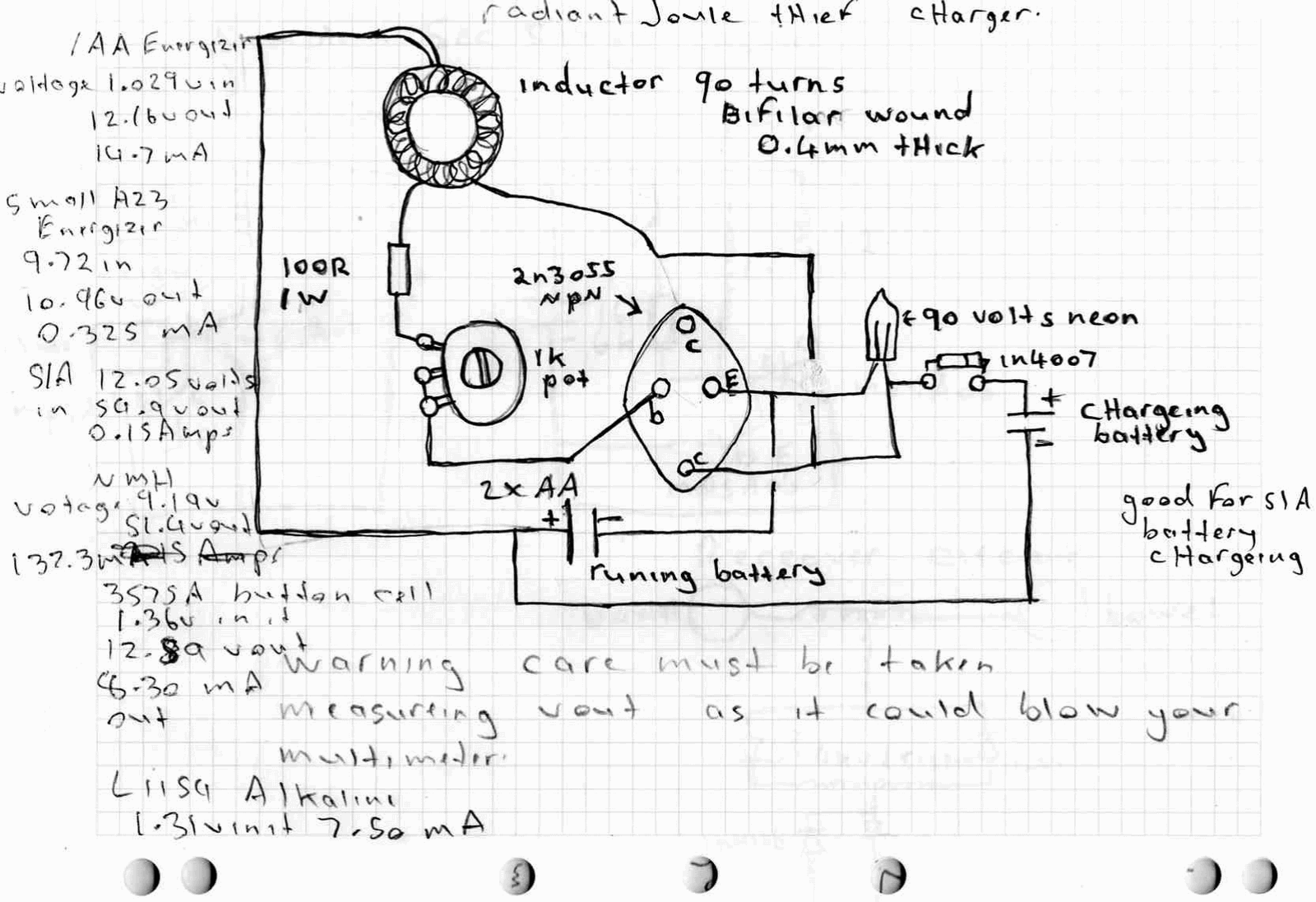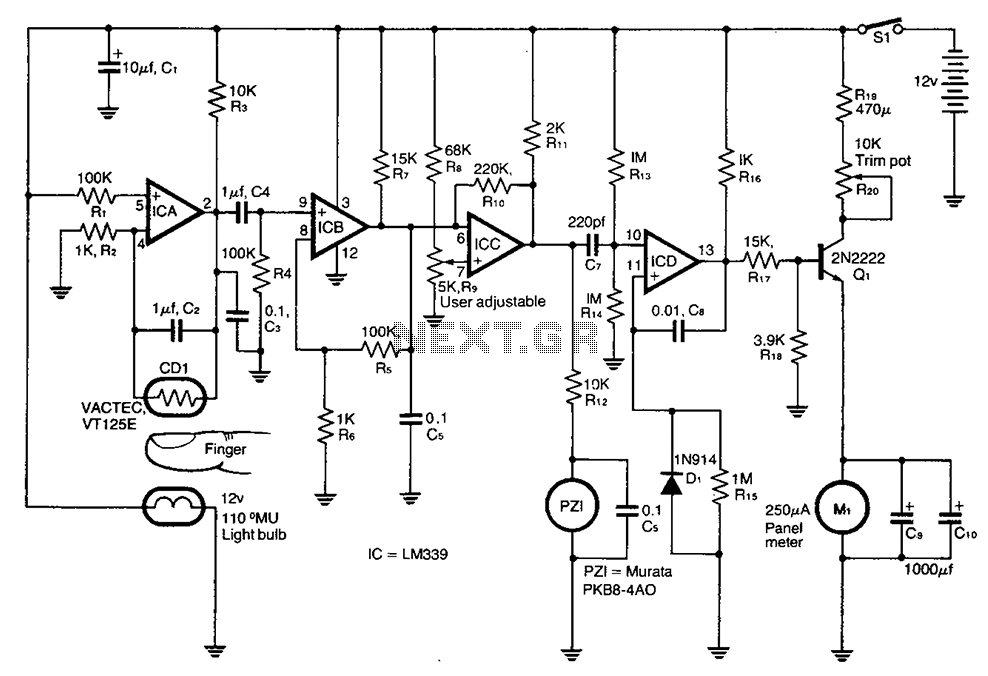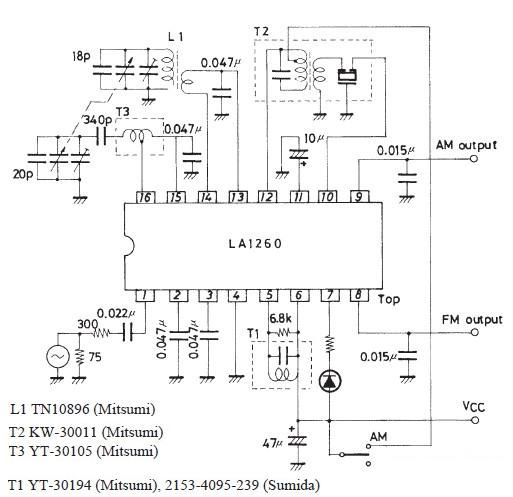
MC14093 pulse width modulation controller circuit design
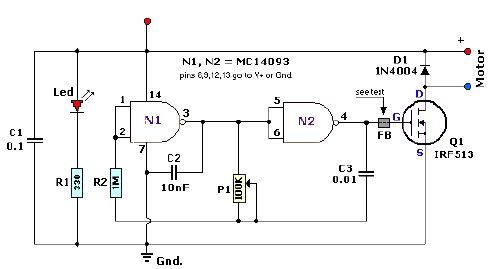
A quad 2-input NAND Schmitt trigger circuit can be designed using the MC14093 CMOS type IC, which serves as a simple pulse width modulation (PWM) controller electronic project. This PWM controller is straightforward and requires only a few external electronic components. The speed can be adjusted from 0 to maximum, with the maximum RPM being two-thirds of the supply voltage. The supply voltage for this project can range from 3 to 18 volts. The MC14093 CMOS type IC can be directly substituted with the MC14011 CMOS IC. Input pins 8, 9, 12, and 13 must be connected to ground or V+. The output pins 10 and 11 are left floating. The maximum current draw, with the specified components, is approximately 220 mA when using a small motor. To reduce radio frequency interference (RFI), a ferrite bead should be placed on the gate of Q1. Additionally, a Schottky diode with appropriate specifications may be necessary for some motors that require faster switching.
The MC14093 IC is a versatile component that integrates multiple NAND gates with Schmitt trigger characteristics, allowing for stable operation in noisy environments. The Schmitt trigger configuration provides hysteresis, which is beneficial in PWM applications as it allows for clean transitions between high and low states, minimizing the risk of oscillation.
In designing the PWM circuit, the input pins (8, 9, 12, and 13) are crucial for setting the logic levels that control the output behavior. These pins, when connected to ground or the positive supply voltage, determine the triggering conditions for the NAND gates. The output pins (10 and 11) can be configured to drive a load, such as a small motor, with the PWM signal, effectively controlling its speed.
The adjustable speed feature of the PWM controller is achieved by manipulating the duty cycle of the output signal. This can be done by varying the resistance or capacitance in the timing network associated with the NAND gates. The maximum RPM being two-thirds of the supply voltage indicates that the controller is designed for efficiency, ensuring that the motor operates within safe limits.
In applications where RFI could affect circuit performance, the inclusion of a ferrite bead on the gate of Q1 serves to suppress high-frequency noise. This is particularly important in PWM applications, where rapid switching can generate interference that may disrupt other electronic devices.
For motors with specific requirements for rapid switching, the use of a Schottky diode is recommended. This type of diode has a lower forward voltage drop and faster switching capabilities compared to standard diodes, making it suitable for high-frequency applications. Proper selection of the diode specifications is essential to ensure reliable operation and prevent damage to the motor or the PWM circuit.
Overall, this PWM controller circuit utilizing the MC14093 CMOS IC is a practical solution for speed control in various electronic projects, combining simplicity with effective performance.Using a MC14093 CMOS type IC, a quad 2-input NAND Schmitt trigger circuit can be designed a very simple pulse width modulation circuit controller electronic project. This pulse width modulation controller electronic project is very simple and require few external electronic parts.
The speed is adjustable from 0-max. Max rpm is 2/3 the supply vol tage. Supply voltage that can be used in this project can be between 3 and 18 volt. MC14093 CMOS type IC can be directly interchanged with the MC14011 CMOS IC. Input pins 8, 9, 12, and 13, need to be connected to Gnd. or `V+`. Output pins 10 & 11 are left floating. Maximum current draw, with the components shown, is approximately 220 mA max using a small type motor. To minimize RFI (Radio Frequency Interference), put a Ferrite Bead on the gate of Q1. A schottky diode of proper specs may be required for some motors which require faster switching. 🔗 External reference
The MC14093 IC is a versatile component that integrates multiple NAND gates with Schmitt trigger characteristics, allowing for stable operation in noisy environments. The Schmitt trigger configuration provides hysteresis, which is beneficial in PWM applications as it allows for clean transitions between high and low states, minimizing the risk of oscillation.
In designing the PWM circuit, the input pins (8, 9, 12, and 13) are crucial for setting the logic levels that control the output behavior. These pins, when connected to ground or the positive supply voltage, determine the triggering conditions for the NAND gates. The output pins (10 and 11) can be configured to drive a load, such as a small motor, with the PWM signal, effectively controlling its speed.
The adjustable speed feature of the PWM controller is achieved by manipulating the duty cycle of the output signal. This can be done by varying the resistance or capacitance in the timing network associated with the NAND gates. The maximum RPM being two-thirds of the supply voltage indicates that the controller is designed for efficiency, ensuring that the motor operates within safe limits.
In applications where RFI could affect circuit performance, the inclusion of a ferrite bead on the gate of Q1 serves to suppress high-frequency noise. This is particularly important in PWM applications, where rapid switching can generate interference that may disrupt other electronic devices.
For motors with specific requirements for rapid switching, the use of a Schottky diode is recommended. This type of diode has a lower forward voltage drop and faster switching capabilities compared to standard diodes, making it suitable for high-frequency applications. Proper selection of the diode specifications is essential to ensure reliable operation and prevent damage to the motor or the PWM circuit.
Overall, this PWM controller circuit utilizing the MC14093 CMOS IC is a practical solution for speed control in various electronic projects, combining simplicity with effective performance.Using a MC14093 CMOS type IC, a quad 2-input NAND Schmitt trigger circuit can be designed a very simple pulse width modulation circuit controller electronic project. This pulse width modulation controller electronic project is very simple and require few external electronic parts.
The speed is adjustable from 0-max. Max rpm is 2/3 the supply vol tage. Supply voltage that can be used in this project can be between 3 and 18 volt. MC14093 CMOS type IC can be directly interchanged with the MC14011 CMOS IC. Input pins 8, 9, 12, and 13, need to be connected to Gnd. or `V+`. Output pins 10 & 11 are left floating. Maximum current draw, with the components shown, is approximately 220 mA max using a small type motor. To minimize RFI (Radio Frequency Interference), put a Ferrite Bead on the gate of Q1. A schottky diode of proper specs may be required for some motors which require faster switching. 🔗 External reference
